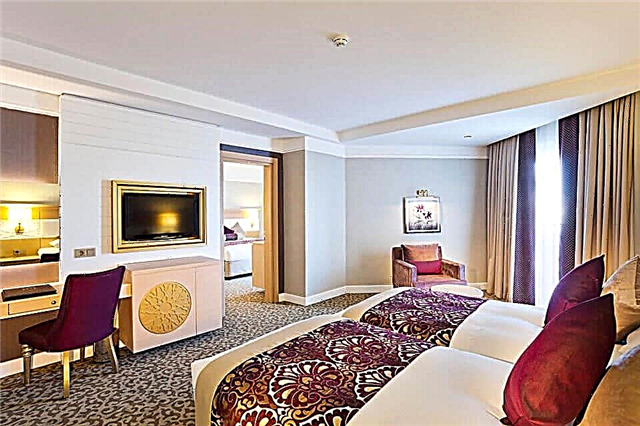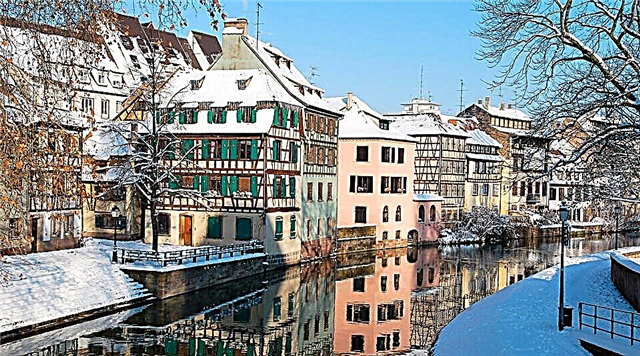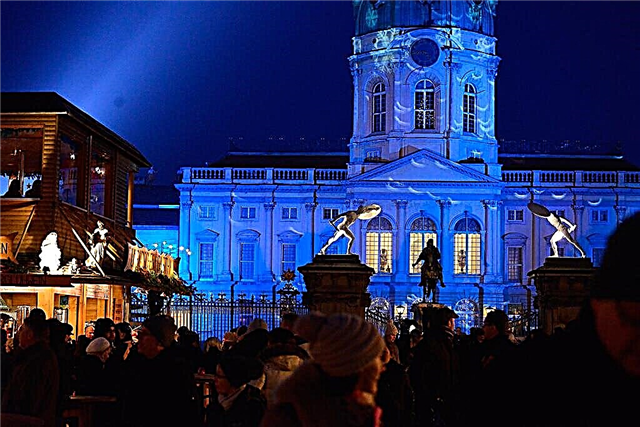To see the famous palaces of the Kaisers of Prussia, it is not necessary to go to Potsdam - the capital of the Federal Republic of Germany also has something to show history lovers. Charlottenburg Castle in Berlin is an architectural complex and the largest residence where seven generations of the Hohenzollern dynasty stayed. The luxurious Baroque building and the unique garden adjoining it make the former Reina Sofia Charlotte country house a real treat for the eyes.
Construction history

In 1694, Duchess Sophia Charlotte of Hanover, wife of the Elector of Brandenburg, the future Emperor of Prussia, received a gift from her husband on the banks of the Spree, seven kilometers from Berlin. At that time, this area was a secluded idyll, the silence of which was broken only by the small village of Lietzow. In June 1695, Johann Arnold Nering began construction of a small summer house. The work of the architect, who died in October of the same year, was continued by Martin Grünberg.
The coronation of Frederick I, which took place in 1701, was the reason for the expansion of the two-story residence, which bore the name of Litzenburg. 4 years later, after the death of the 36-year-old queen, the emperor renamed the palace to Charlottenburg and entrusted the architect Eosander von Goethe with the construction of the west wing. Between 1709 and 1712, the risalit of the building received a dome. All subsequent owners supplemented the architectural ensemble with new elements.
After the First World War, the abandoned Charlottenburg was taken over by the Office of Palaces and Parks. In 1945, the building was almost completely destroyed, and at the end of the 40s, the city authorities decided to demolish it. The residence owes its restoration to one person - Margarete Kühn, who defended the castle and later became its headmistress. Restoration work began in the 50s of the XX century. Carried out according to the original drawings, they returned to Berlin a historical monument that delights visitors with the splendor of the decor.
Architecture

Charlottenburg Castle is an example of German Baroque architecture with rococo elements. The main building with eleven axial windows is complemented by two side wings, which together form a large front yard. The structure of bright yellow color with gray contrasting details, 505 m long, is located behind an elegant fence, consisting of high peaks with eight-pointed stars - signs of the Order of the Black Eagle, established by the first emperor of Prussia. On the gates there are sculptures of disco throwers facing each other.
A bronze statue of the Great Elector rises on a marble pedestal in front of the main entrance. It is noteworthy that both the rider and the horse are monoliths - their figures were cast together. The sculptures at the foot of the monument personify the types of human temperament: phlegmatic, sanguine, choleric and melancholic.
The central part of the façade is dominated by a massive 48-meter tower topped with a green dome. Its balustrade is decorated with allegorical figures symbolizing science. A gilded statue of the goddess Fortune is frozen on the spire in a graceful dance step.
Interior

The interior decoration is made in the best traditions of the Baroque and Rococo: here you will find elaborate decoration, fancy volumetric stucco molding, and many statues. Both rich and soft pastel colors, generously diluted with golden elements, were used in the design of the walls. The halls and private quarters of the members of the royal family are furnished with carvings and rich inlays.
The bohemian ceilings, adorned with monumental painting, ornate cladding and colorful frescoes with precisely drawn themes, should not be overlooked. Crystal chandeliers and exquisite candelabra give soft light to the rooms. The decor of the floor, covered with parquet or ceramic tiles, is in harmony with the overall concept of the rooms.
Many rooms are decorated with handmade tapestries, huge mirrors in graceful frames and works of German painters. In the gallery under the dome, Russian guests will be surprised to learn the portrait of Peter I, who visited the castle during his European trip. By the way, the mysterious Amber Room, presented to the first Russian emperor, was created for Charlottenburg.
What to see
The main building includes the premises of the old palace and a new wing adjoining it from the east, which appeared in the period 1740-1742. An imposing entrance in the center of the elongated structure, accentuated by double columns and a balcony, leads to the state rooms and summer rooms. Today, furniture of monarchs, precious snuff boxes, cutlery made of gold, silver and porcelain, sculptures and paintings are exhibited here. One of the galleries houses the largest collection of paintings by Antoine Watteau in Germany.
Main wing

The main attraction of the main wing is the circular vaulted reception hall with gold sculpture in bas-relief and numerous niches with marble figures. Arched windows overlook the park. This is followed by the emperor's winter bedroom and chapel. Here, under the oak pulpit, stands the original altar table. Opposite is the royal box. Angels are holding a crown and a Prussian eagle - a symbol of power. The suite is completed by a tapestry hall and a porcelain study.
Golden hall

The Golden Gallery is a festively decorated ballroom and one of the most beautiful Rococo salons in Europe. The doors and pastel green walls and ceilings are decorated with precious stucco. Decor elements - cheerful cherubs, fruits, fancifully intertwined tree branches - shine with the brilliance of gilding. The 42 m long rectangular elongated room enchants visitors with the splendor of crystal and mirrors.
White Hall
Unlike the rest of the premises, this room is designed in a classic style. It also sparkles with a crystal chandelier and gold-trimmed pilasters. But the white walls and simple arched windows give the former dining room of Frederick the Great austere features. Unfortunately, the original ceiling, painted by the court painter Antoine Pesne, has not survived to this day. Now the White Hall is decorated with a plafond with an abstract pattern, the color palette of which repeats the motifs of the lost canvas.
Porcelain cabinet

On the basement floor there is a room, the walls of which are decorated with huge mirrors in gold frames. This is a famous porcelain cabinet, created in 1706 by Baron von Goethe, the famous architect of Prussia. Aware of Sofia Charlotte's passion for the art of the East, the king presented her with a gift of a salon containing a priceless collection of more than 2,700 white and blue Chinese and Japanese porcelains. Each item is hand-painted. The ceiling is decorated with a plafond - a real work of painting, introducing visitors to allegorical characters, personifying the seasons, parts of the world and zodiacal signs.
Large greenhouse
In the western part of the building is the 1,156 m2 Large Conservatory, built between 1709 and 1712. In the colder months, about two hundred orange and lemon trees hibernated in the daylight-flooded rooms. In the summer, the greenhouse was regularly used as a venue for court festivals and balls. In 1943, the building fell into ruins and was rebuilt after 19 years. Today it is used for gala receptions, dinners and concerts.
Modern Charlottenburg

Today, the former possession of the Hohenzollerns is not only a museum and an architectural monument, but also one of the centers of the capital's cultural life. Concerts and receptions are regularly held in the Great Greenhouse, accompanied by performances by the Berlin Residency Orchestra. The musicians, dressed in original Baroque costumes, perform classical pieces from the 18th century. Here you can turn your child's birthday into a real holiday.Little guests, dressed in magnificent outfits, will be happy not only to enjoy delicious dishes, but also to become real members of the imperial court for a while.
Those wishing to pamper themselves with coffee and pastries can visit the outdoor café. Friendly staff awaits guests daily from 11:00 to 19:00. During Advent (four weeks before Catholic Christmas), the castle provides an atmospheric backdrop for a cozy fair, inviting to warm up with scalding mulled wine, satisfy hunger with national grilled sausages and buy traditional handicrafts and souvenirs.
The park

The palace is framed by a magnificent park - an ideal place for walks and relaxation. In 1697, Sophia Charlotte invited Simeon Gordot, a student of the famous Versailles gardener André Le Notre, to create the first French baroque garden in German lands. Its opening took place two years later and was marked by a magnificent celebration. The talented and highly educated queen used her new domain not only for festivals with music, dance and theatrical performances, but also for private conversations and disputes with the philosopher Gottfried Wilhelm Leibniz.
In connection with the expansion of the imperial court in 1701 and the arrival of a new fashion in English landscapes, part of the territory has undergone changes. However, after the destruction of World War II and subsequent reconstruction, the atmosphere of the former baroque garden was restored.
Today the classic Versailles design is defined by strict geometric lines. Four paths, separated by lawns, originate from the castle. They are adjoined by parterre flower beds and curb shrubs that form a graceful ornament. In the center there is an octagonal pool with a fountain. Numerous sculptures and a ten-meter marble obelisk serve as decorations.
In the northern part there is a wide staircase leading to the reservoir. During Charlotte's time, it was connected to the Spree River and served as a port for ornate gondolas on which the Queen traveled from the city's Berlin Palace to her country residence. Today the former harbor is the Carp Pond, which has the shape of a rectangle and is decorated with a humped bridge on one side.
Gazebo

On the banks of the Spree, in the shade of linden alleys, hides the Belvedere, built by the architect Karl Gotthard Langhan in 1788. The king used the neoclassical building as a viewing pavilion and a tea house. It also hosted the rituals of conjuring spirits organized by the mystical society of the Rosicrucians, to which Frederick Wilhelm II belonged. Today, the Belvedere houses an exposition of porcelain products. The focus is on the world's largest collection of unique pieces from the Berlin Royal Porcelain Manufactory, founded in 1763.
New pavilion
The structure to the east of the castle was built in 1824/25 by Karl Friedrich Schinkel. Built in the style of a Neapolitan villa, the building was intended for a secluded summer vacation for the monarch. Destroyed during World War II, the pavilion was rebuilt in 1957/60. After a general reconstruction in 2011, an art gallery was opened here.
The three rooms on the ground floor are furnished with original pieces of furniture and convey the true impression of the summer house of the ruler of Prussia. Samples of German portrait painting are exhibited in the adjacent rooms. The upper rooms are dedicated to Schinkel's drawings and sketches and paintings by his contemporaries: Caspar David Friedrich, Eduard Gartner and Karl Blechen.
Mausoleum

In the northwestern part of the garden is the Mausoleum, where members of the Hohenzollern dynasty are buried. In 1810, after the sudden death of his beloved wife Louise, Friedrich Wilhelm III ordered to erect the building in the form of a small ancient temple. Ideas and sketches belonged to the king, the work on the project was led by the architect Heinrich Gentz. The role of a consultant was assigned to the famous architect Karl Friedrich Schinkel.
The altar, crucifix and biblical sayings on the walls give the building the character of a chapel. In 1840, the premises were expanded in connection with the installation of the sarcophagus of the third monarch of Prussia. The building was enlarged again in 1888 after the death of Kaiser Wilhelm I and his wife Augusta. Under the memorial hall, the second wife of Friedrich Wilhelm III, Countess Augusta von Harrach and Prince Albrecht, sleep in eternal sleep.
Opening hours and ticket prices

The castle is open from Tuesday to Sunday from 10:00 to 18:00 (from 01.04. To 31.10.) And from 10:00 to 17:00 (from 01.11. To 31.03.). Ticket offices are located next to the main entrance. The last guest is allowed 30 minutes before the end of the work. The visit is not possible on 24.12, 25.12. and 31.12 after 14:00. The park is open year-round from 8:00 to sunset. Free admission.
The entrance ticket price is:
- main wing: standard fare - 12 €, concessionary - 8 €
- new wing: standard - 6 €, reduced - 5 €
- Belvedere, New Pavilion: standard - 4 € and concessionary - 3 €
- temporary exhibitions: up to 14 €
- Mausoleum: Free
The price includes the use of the audio guide (available in German and English). By paying 3 euros, you get a permit for indoor photography (without flash and tripod).
You can also purchase a Charlottenburg + Combined Ticket, which entitles you to all galleries and pavilions (excluding temporary exhibitions). Price: standard - 17 €, reduced - 13 €. With a Berlin WelcomeCard, you have a 25% discount on the Ticket charlottenburg +. Children under 7 years old are admitted free.
Where is it located and how to get there

The palace complex is located in the west of Berlin - in the Charlottenburg-Wilmersdorf area. Thanks to the well-developed transport infrastructure and the availability of ground parking, it will not be difficult to get to the attraction.
- Car: Distance from the A100 motorway - 0.8 km. In front of the Great Greenhouse, guests of the palace are provided with 120 parking spaces. The nearest 24-hour parking is located at Spandauer Damm 10. Price - 2 euros per hour.
- Bus: Routes M45 and 309 to the Schloss Charlottenburg stop, 109 to Luisenplatz / Schloss Charlottenburg.
- Train (S-Bahn): S41, 42 and 46 to Westend Station. Spandauer Damm street leads directly from it to the castle. Travel time is 13 minutes.
- Subway (U-Bahn):
- U7 to Richard Wagner Platz station, then walk 450 m along Otto-Suhr-Allee. Then turn right, walk about 100 m along Luisenplatz, turn left. After 240 m you will see the main entrance. Travel time is 15 minutes.
- U2 to Sophie-Charlotte Platz station. When exiting the metro, turn right onto Horstweg, and after 70 m turn left onto Schloßstraße. She will lead you to the palace. Travel time is 18 minutes.
The exact address is Spandauer Damm 10-22, 14059 Berlin.
Coordinates for the navigator: 52 ° 31'15.4 ″ N 13 ° 17'44.3 ″ E.











